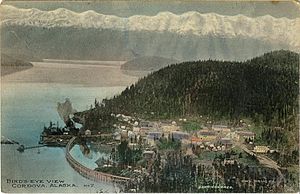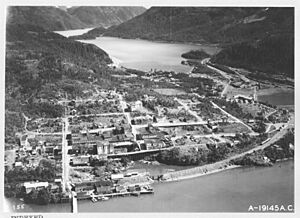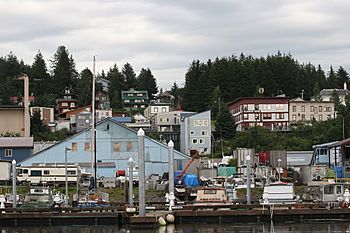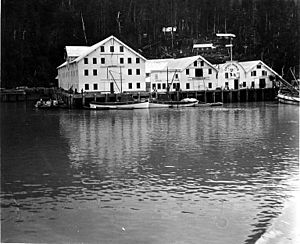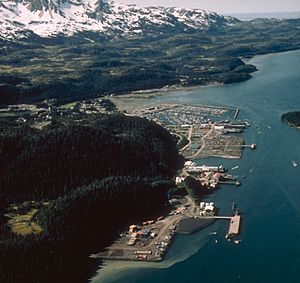Cordova, Alaska facts for kids
Quick facts for kids
Cordova
|
|
|---|---|
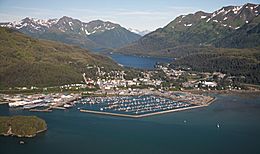
Aerial view of central Cordova, Eyak Lake and the portion of the Chugach Mountains surrounding the city.
|
|
| Nickname(s):
The Crossroads of Alaska
|
|
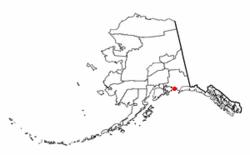
Location of Cordova, Alaska
|
|
| Country | United States |
| State | Alaska |
| Census Area | Chugach |
| Incorporated | July 8, 1909 |
| Area | |
| • Total | 75.14 sq mi (194.62 km2) |
| • Land | 61.35 sq mi (158.89 km2) |
| • Water | 13.80 sq mi (35.73 km2) |
| Elevation | 82 ft (25 m) |
| Population
(2020)
|
|
| • Total | 2,609 |
| • Density | 42.53/sq mi (16.42/km2) |
| Time zone | UTC-9 (Alaska (AKST)) |
| • Summer (DST) | UTC-8 (AKDT) |
| ZIP code |
99574
|
| Area code | 907 |
| FIPS code | 02-17410 |
| GNIS feature ID | 1421215 |
| Website | CityofCordova.net |
Cordova is a city in Chugach Census Area, Alaska, United States. It's located near the mouth of the Copper River. The city sits at the head of Orca Inlet on the east side of Prince William Sound. In 2020, about 2,609 people lived there.
Spanish explorer Salvador Fidalgo named the area Puerto Córdoba in 1790. Cordova is unique because no roads connect it to other Alaskan towns. You need to travel by plane or ferry to get there. In 1989, the Exxon Valdez oil spill happened nearby. This event greatly affected the local environment and fishing industry.
Contents
History of Cordova
In 1790, a Spanish explorer named Salvador Fidalgo called the inlet near today's Cordova "Puerto Cordova." The city later got its name from this inlet, though the inlet is now called Orca Inlet.
Cordova was founded because of a big discovery. Rich copper ore was found at Kennecott, north of Cordova. Surveyors from Valdez planned out the town. Michael James Heney bought land for the end of the Copper River and Northwestern Railway. He chose Cordova because the nearby town of Katalla had a poor harbor.
Heney and his team officially started the town on March 26, 1906. A week later, work began on the railroad. The first land lots in Cordova were sold in May 1908. As the railroad grew, so did the town. Schools, businesses, a hospital, and utilities were built.
After the railroad was finished, Cordova became a major hub. It was where copper ore from Kennecott was transported. From 1911 to 1938, over 200 million tons of copper ore passed through Cordova.
The Eyak people have lived in the area around Cordova for a long time. Chugach people lived to the west. Ahtna and Tlingit people also visited for trade or battles. The last person who spoke the Eyak language fluently, Marie Smith Jones, passed away in 2008. However, the native people and their traditions are still strong in the region.
Cordova was once famous for its razor clam industry. From 1916 to the late 1950s, it was known as the "Razor Clam Capital of the World." At its peak, people harvested 3.5 million pounds of clams. But harvests started to drop in the late 1950s. This was likely due to too much harvesting and a big die-off in 1958.
The 1964 Good Friday earthquake destroyed the clam industry. In some places, the ground rose up by six feet. This exposed the clam beds, which were already low on clams. There hasn't been much commercial clam harvesting since 1988.
In March 1989, the Exxon Valdez oil tanker hit Bligh Reef. This happened north of Cordova. It caused one of the worst environmental disasters in North America. The Exxon Valdez oil spill badly affected the area's salmon and herring populations. This led to problems for the local fishing economy. It also disrupted the natural environment. Cleanup efforts began, but some effects, like fewer birds, are still seen today.
Cordova's Population
| Historical population | |||
|---|---|---|---|
| Census | Pop. | %± | |
| 1910 | 1,152 | — | |
| 1920 | 955 | −17.1% | |
| 1930 | 980 | 2.6% | |
| 1940 | 938 | −4.3% | |
| 1950 | 1,165 | 24.2% | |
| 1960 | 1,128 | −3.2% | |
| 1970 | 1,164 | 3.2% | |
| 1980 | 1,879 | 61.4% | |
| 1990 | 2,110 | 12.3% | |
| 2000 | 2,454 | 16.3% | |
| 2010 | 2,239 | −8.8% | |
| 2020 | 2,609 | 16.5% | |
| U.S. Decennial Census | |||
Cordova first appeared on the U.S. Census in 1910. It became an official city in 1909.
In 2010, there were 2,239 people living in Cordova. Most residents were White (68.3%). Other groups included Native American (8.7%) and Asian (10.7%). About 4.2% of the population was Hispanic or Latino.
In 2000, there were 2,454 people. About 36% of households had children under 18. The average household had 2.48 people. The median age was 37 years old.
Geography and Climate
Cordova is located within the Chugach National Forest. The city covers about 75.6 square miles (196 km2). Most of this area is land, with about 14.3 square miles (37 km2) being water.
Cordova's Climate
Cordova has a cool, wet climate. Summers are mild and rainy. Winters are moderately cold and snowy. It rains a lot all year round. This is because of the Chugach Mountains. Winds from the Pacific Ocean hit the mountains and rise. This causes the air to cool, forming clouds and rain.
On average, Cordova gets about 148 inches (376 cm) of rain each year. It rains about 125 days a year. Snow mainly falls from December to March. About 127 inches (3.2 m) of snow falls yearly. Winter temperatures can drop to about 15°F (-9°C). Summer temperatures can reach around 77°F (25°C).
Most weather data is taken at the airport, which is 11 miles (18 km) from the city. Temperatures and rain can be very different between the city and the airport. The city often gets twice as much rain as the airport.
| Climate data for Cordova, Alaska (1991–2020 normals, extremes 1909–present) | |||||||||||||
|---|---|---|---|---|---|---|---|---|---|---|---|---|---|
| Month | Jan | Feb | Mar | Apr | May | Jun | Jul | Aug | Sep | Oct | Nov | Dec | Year |
| Record high °F (°C) | 59 (15) |
58 (14) |
68 (20) |
74 (23) |
82 (28) |
90 (32) |
89 (32) |
86 (30) |
78 (26) |
72 (22) |
60 (16) |
66 (19) |
90 (32) |
| Mean maximum °F (°C) | 47.0 (8.3) |
46.6 (8.1) |
49.5 (9.7) |
58.9 (14.9) |
70.1 (21.2) |
74.8 (23.8) |
74.5 (23.6) |
73.8 (23.2) |
66.5 (19.2) |
56.7 (13.7) |
49.3 (9.6) |
46.0 (7.8) |
78.9 (26.1) |
| Mean daily maximum °F (°C) | 33.7 (0.9) |
36.7 (2.6) |
39.1 (3.9) |
46.5 (8.1) |
54.1 (12.3) |
59.4 (15.2) |
61.6 (16.4) |
61.9 (16.6) |
56.4 (13.6) |
47.5 (8.6) |
38.4 (3.6) |
35.3 (1.8) |
47.5 (8.6) |
| Daily mean °F (°C) | 26.4 (−3.1) |
29.1 (−1.6) |
30.8 (−0.7) |
38.1 (3.4) |
45.5 (7.5) |
51.4 (10.8) |
54.6 (12.6) |
54.1 (12.3) |
48.4 (9.1) |
40.1 (4.5) |
31.6 (−0.2) |
28.9 (−1.7) |
39.9 (4.4) |
| Mean daily minimum °F (°C) | 19.0 (−7.2) |
21.4 (−5.9) |
22.5 (−5.3) |
29.8 (−1.2) |
36.8 (2.7) |
43.5 (6.4) |
47.6 (8.7) |
46.4 (8.0) |
40.3 (4.6) |
32.7 (0.4) |
24.8 (−4.0) |
22.4 (−5.3) |
32.3 (0.2) |
| Mean minimum °F (°C) | −2.2 (−19.0) |
2.1 (−16.6) |
5.3 (−14.8) |
18.1 (−7.7) |
27.3 (−2.6) |
34.0 (1.1) |
38.6 (3.7) |
36.0 (2.2) |
28.3 (−2.1) |
19.4 (−7.0) |
7.9 (−13.4) |
3.2 (−16.0) |
−7.1 (−21.7) |
| Record low °F (°C) | −30 (−34) |
−33 (−36) |
−24 (−31) |
−9 (−23) |
19 (−7) |
23 (−5) |
33 (1) |
23 (−5) |
20 (−7) |
−1 (−18) |
−17 (−27) |
−23 (−31) |
−33 (−36) |
| Average precipitation inches (mm) | 6.22 (158) |
5.95 (151) |
4.69 (119) |
4.48 (114) |
5.41 (137) |
4.58 (116) |
5.70 (145) |
9.93 (252) |
13.21 (336) |
10.88 (276) |
7.16 (182) |
7.97 (202) |
86.18 (2,188) |
| Average snowfall inches (cm) | 20.6 (52) |
18.7 (47) |
20.0 (51) |
4.9 (12) |
0.8 (2.0) |
0.0 (0.0) |
0.0 (0.0) |
0.0 (0.0) |
0.0 (0.0) |
1.1 (2.8) |
9.9 (25) |
24.5 (62) |
100.5 (253.8) |
| Average precipitation days (≥ 0.01 in) | 17.3 | 15.6 | 15.4 | 16.5 | 17.2 | 17.2 | 19.2 | 19.7 | 21.1 | 20.8 | 17.9 | 19.7 | 217.6 |
| Average snowy days (≥ 0.1 in) | 8.1 | 7.1 | 7.9 | 3.0 | 0.1 | 0.0 | 0.0 | 0.0 | 0.0 | 1.0 | 5.6 | 8.7 | 41.5 |
| Source 1: NWS | |||||||||||||
| Source 2: NOAA (average snowfall/snow days 1981–2010) | |||||||||||||
Economy and Jobs
Commercial fishing is the main industry in Cordova. In fact, at least one person in half of all Cordova homes works in fishing or fish processing. The fishing boats mainly work in the Prince William Sound and Copper River Delta areas.
There are different types of fisheries here. The most important one for the economy is the salmon fishery. All kinds of Pacific salmon are caught, except for the cherry salmon. Fishermen use nets like purse seines, drift gillnets, or set gillnets. The Alaska Department of Fish and Game regulates all fishing. Alaska's fisheries have a special permit system.
The first fish processing plant near Cordova opened in 1887. In 2009, there were many permits used for fishing in the Prince William Sound and Copper River Delta area.
Fun Things to Do in Cordova
Cordova hosts many festivals and celebrations throughout the year.
Copper River Delta Shorebird Festival
This festival happens every May. Millions of migrating shorebirds stop here to rest and eat. They are on their way north. You can see many western sandpipers, least sandpipers, and dunlins. This is a great time for bird watchers to visit. The festival offers activities, workshops, and bird watching tours.
Cordova Iceworm Festival
The Iceworm Festival takes place every February. It includes a parade, a talent show, and a royal crowning ceremony. There are also fun competitions like an oyster shucking contest, ping pong tournament, and a survival suit race.
Copper River Wild Salmon Festival
This festival is held in July at the Mt. Eyak ski area.
- Salmon Jam Music Festival: This is a main event and a fundraiser for Cordova Arts. Local musicians perform, followed by professional acts. It takes place on Friday and Saturday nights.
- Taste of Cordova: This event kicks off the festival. It's a cooking contest using wild, local foods and Copper River salmon. Guest chefs and food writers judge the entries.
- Alaska Salmon Runs: These races start on Saturday morning. They include a marathon, half marathon, 10k, 5k, and a 1-mile race on the Copper River Highway.
- Small Fry Activities: These are educational events for children and families. They happen during the races.
Local Museums and Culture
- Cordova Historical Museum: This museum has exhibits about the Copper River and Northwestern Railway. It also shows the local fishing industry and Alaska Natives. They also host an art show called "Fish Follies."
- Ilanka Cultural Center: This museum features exhibits on Eyak, Alutiiq, Ahtna, and Tlingit history. It includes artifacts, photos, and oral histories. One special exhibit is Eyak, a 24-and-a-half-foot orca whale skeleton. It's one of only five fully put-together orca skeletons in the world.
The Cordova Ikumat Alutiiq group started in 1995. It's open to youth and adults. The group performs old songs and new ones. The Ilanka Cultural Center also teaches traditional arts and skills. These include skin sewing, beadwork, and carving masks, totems, and ivory. They also teach how to prepare fish and deer, pick berries, and make jam.
Cordova Center
In late 2010, work began on the Cordova Center. This is a large community center. It opened in the winter of 2015. The Cordova Center has a new library, museum, auditorium, and meeting spaces. It also houses city hall offices. Many events happen here, like community movie nights, winter bazaars, and art shows.
Sports and Outdoor Fun
Winter Sports
Skiing is very popular in winter. The nearby Chugach Mountains have great slopes for backcountry skiing. The Mt. Eyak ski area has a single chair ski lift and a rope tow. It's the oldest working ski lift in North America! Snowshoeing and ice skating are also popular when the conditions are right.
Hiking Trails
You can go Hiking all year round on many trails. Some are close to the city. Others are a short drive away.
- Eyak River Trail: Found at Copper River Highway mile 5.7.
- Alaganik Slough Trail: Take Copper River Highway to mile 16.9. Turn south on Alaganik Slough Road. Follow the main road for 2.9 miles. The trail starts on the east side of the road.
- Pipeline Lakes Trail: Located at Copper River Highway mile 21.4.
- McKinley Lake Trail: Found at Copper River Highway mile 21.6.
- Saddlebag Glacier Trail: Take Copper River Highway to mile 24.6. Turn north on the firewood cutting road. The trail starts one mile away at the end of the road.
Summer Activities
In the summer, kayaking in Prince William Sound is popular. The Sound has more tidewater glaciers than any other place in North America. A huge area of the western Sound is protected as the Nellie Juan College Fjord Wilderness Study Area.
Indoor Recreation
For indoor fun, there's the Bob Korn Memorial Pool. The Bidarki Fitness Center has a gym with a basketball court, a weight room, and cardio equipment.
Disc Golf
The Meals Reservoir Disc Golf Course opened in 2018. It's a public disc golf course near Meals Reservoir off Whitshed Road.
Education in Cordova
The Cordova School District runs the schools in the community. Mt. Eccles elementary school is the only public elementary school in Cordova. In 2008, it had 206 students. Public secondary education is provided by a combined junior and senior high school. In 2008, the high school had 205 students. The district employs 26 teachers.
For education after high school, there's the Prince William Sound College. This is a community campus of the University of Alaska Anchorage.
Media and News
The city's newspaper is the Cordova Times. It started in 1914 and is published every Friday.
There are three radio stations in the area:
- KLAM (1450 AM): Started in 1954. It plays classic rock, country, news, and talk shows.
- KCDV (100.9 FM): Started in 1997. It plays top hits, '80s, and '90s music.
- KCHU: Based in Valdez, this station broadcasts public radio programming at 88.1 FM in Cordova.
The Cordova area is often shown in ski films by director Warren Miller.
Getting Around Cordova
Cordova is on the mainland, but you can only reach it by boat or plane. There are no roads connecting it to other cities. The railroad used to be a way to get there, but it's no longer used. This is mostly because of the 1964 Good Friday earthquake. The earthquake damaged the Million Dollar Bridge.
The longest road is the Copper River Highway. It follows the old railroad path for about 49.5 miles (79.7 km). The first 11 miles (18 km) east of Cordova are paved. The rest is gravel. As of 2011, cars can only go up to the 36-mile mark. A bridge washed out due to changes in the river. You can still reach the next 13.5 miles by crossing the river by boat.
You can bring cars and trucks to Cordova by ferry. The state-owned Alaska Marine Highway System provides regular ferry service. Ferries go to Valdez and Whittier. They also make stops in Tatitlek and Chenega Bay if there are reservations. The M/V Aurora operates in Prince William Sound all year.
Cordova has two airports:
- Merle K. (Mudhole) Smith Airport: This state-owned airport is 11 miles (18 km) east of the city. Alaska Airlines offers regular jet service here. Its main runway is 7,500 feet (2,286 m) long and made of asphalt.
- Cordova Municipal Airport: This state-owned airport is 1 mile (1.6 km) from the city. It's on Lake Eyak, which also has a seaplane landing area. The single runway is 1,800 feet (549 m) long and made of gravel. This airport is mostly used by air taxis and private planes.
Famous People from Cordova
- Marie Smith Jones (1918–2008): She was the last person to speak the Eyak language fluently. She was also the last full-blooded Eyak person.
- Cody McKenzie (born 1987): A professional UFC fighter.
See also
 In Spanish: Córdova (Alaska) para niños
In Spanish: Córdova (Alaska) para niños


